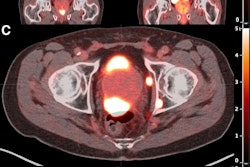SPECT/CT scans taken just four hours after patients begin lutetium-177 (Lu-177) prostate-specific membrane antigen-617 (PSMA-617) treatment can help assess treatment responses, according to researchers in Australia.
A team at St Vincent’s Hospital in Sydney noted that the approach may serve as an alternative to scans performed 24 hours after initial treatment and allow imaging and treatment on the same day, which would be more convenient.
“Lu-177 PSMA-SPECT/CT at 4 hours after injection appears a promising alternative to 24-hour Lu-177 PSMA-SPECT/CT for treatment response assessment, with improved patient convenience,” wrote lead author Mina Swiha, MD, and colleagues. The article was published October 30 in the Journal of Nuclear Medicine.
Lu-177 PSMA-617 (Pluvicto, Novartis) is an effective treatment for metastatic castration-resistant prostate cancer (mCRPC). While studies have shown that gallium-68 (Ga-68) PSMA-PET/CT scans can determine early treatment response, the method has a high cost and limited availability, the authors noted.
Conversely, Lu-177 PSMA-SPECT/CT has shown promise as a potential response biomarker for therapy, but at an inconvenient 24 hours after patients receive the first injection. Thus, in the study, the group analyzed whether scans at four hours could be as informative.
In a retrospective analysis, the researchers enrolled 21 patients on therapy between May and November 2023. Patients underwent post-therapy SPECT/CT at four hours and 24 hours after the first dose, as well as four hours after the second dose (at six weeks). Baseline Ga-68 PSMA-11 PET/CT were also performed.
The researchers compared the results of all three methods both visually and semiquantitatively. They also looked at whether changes in the total tumor volume (TTV) on the four-hour SPECT/CT scans after the first and second doses were correlated to patient outcomes.
 From left to right, maximum-intensity projections of screening Ga-68 PSMA-11 PET/CT, 4-h Lu-177 PSMA-SPECT/CT, and 24-h Lu-177 PSMA-SPECT/CT (top row) and corresponding quantitative maximum-intensity projections (bottom row) of 63-y-old man with mCRPC to regional and distant lymph nodes and widespread osseous metastases showing identical disease distribution on all studies both visually and quantitatively.Image courtesy of the Journal of Nuclear Medicine.
From left to right, maximum-intensity projections of screening Ga-68 PSMA-11 PET/CT, 4-h Lu-177 PSMA-SPECT/CT, and 24-h Lu-177 PSMA-SPECT/CT (top row) and corresponding quantitative maximum-intensity projections (bottom row) of 63-y-old man with mCRPC to regional and distant lymph nodes and widespread osseous metastases showing identical disease distribution on all studies both visually and quantitatively.Image courtesy of the Journal of Nuclear Medicine.
Based on visual analysis, the distribution of disease was unchanged among the three imaging methods, the researchers reported. Mean differences and agreement between four-hour and 24-hour SPECT/CT quantitative parameters were within acceptable bounds for lesion number, maximum standard uptake value (SUVmax), and SUVmean, they noted.
Moreover, changes in TTV between the first and second doses on SPECT/CT predicted patient outcomes, the group wrote. Thirteen patients had disease progression or died a median of 3.9 months after the second dose. The median time of these outcomes was 1.8 months for those with TTV changes of more than 30% on the scans and 8.2 months in those with TTV changes of 30% or less.
“To our knowledge, this was the first study to evaluate the potential of Lu-177 PSMA-SPECT/CT at 4 hours for treatment response,” the group wrote.
As such, more studies are needed, yet these findings add to increasing evidence that imaging response biomarkers can help stratify patients into responders and nonresponders and play an important role in improving personalization of treatment in prostate theranostics, they wrote.
“Optimizing the cost-effectiveness and convenience of imaging response biomarkers will aid their introduction into routine clinical care,” the group concluded.
The full study is available here.




















